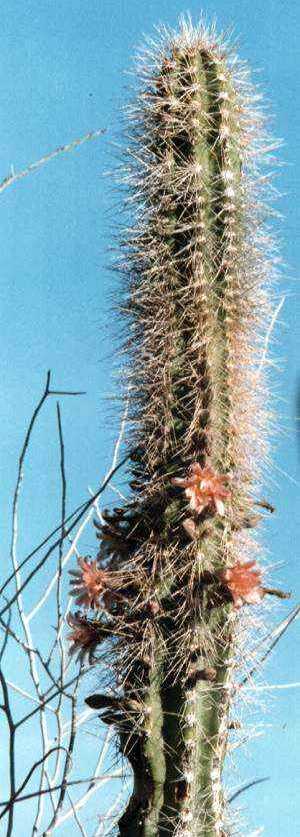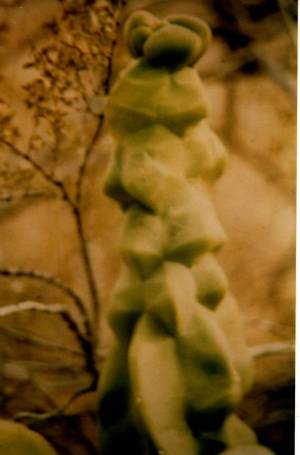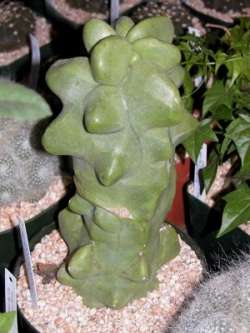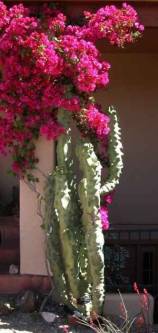|
The monstrous
Lophocereus
Doug Rowland |
| Trevor
has asked me to do a piece on Lophocereus schottii v monstrosus,
which is a very interesting and quite uncommon plant in collections.
However, to make a job of it I will start at the beginning with the
species. |
|
Lophocereus
schottii (Engelmann) Britton and Rose.
This
species was described by Engelmann in 1856, as Cereus schottii, later to
be placed in the genus Lophocereus by Britton and Rose in 1909. Today it
is generally recognised as Pachycereus schottii Hunt 1987. In the United
States and Mexico it is known as the Senita Cactus. (Senita = ‘old one’
in Spanish after the grey bristles.) This is a very distinctive species
and easy to recognise, the tall stems being covered in sharp needle like
grey spines towards their uppermost parts. The species is nocturnal
flowering and is of easy cultivation.
The
plants tend to grow in colonies in favourable locations in dry gravelly
soils. They enjoy warmth and the most northerly stands in Southern Arizona
are smaller in size than their more southerly counterparts.
The tall
stems branch from the base and eventually form clumps 6’ to 21’ tall
and are 4½” to 5” in diameter. The stems as they mature become more
spiny above than below. Flowers and fruits eventually emerge from these
more spiny areas. Occasionally the ends of stems will spiral a little or
dramatically in a right or left hand manner Such top cuttings are much
prized by Californian enthusiasts, fetching high prices. A spiny tip taken
into cultivation will root satisfactorily, but will not grow, throwing out
a single juvenile offset in time. On mature plants the flowers are
greenish white on the underside and pinkish white inside and emit an
unpleasant odour. One or several flowers are produced from each areole.
The flowers open at dusk and continue until early morning when the sun
burns them out, allowing a little photographic opportunity for early
desert risers. The fruits are as red as ripe strawberries and are seldom
seen, as they are quickly taken by hungry desert birds.
There
are three locations where this plant can be found. In Pima County in the
south of Arizona along the Mexican border, this species is at the northern
limit of its range and perhaps there are only around 50 plants here, which
are on the smaller side. Colonies further south in Sonora do progressively
better. It is also fairly common in Baja California down to the Cape
district. Plants will also do well in cultivation in the open in Tucson
and Phoenix in Arizona.
This
species presents no problems in cultivation and will do well in a sunny
spot in a cactus house in a gritty soil mix. Seeds are plentiful in
commerce and many enthusiasts buy and sow these in the hope that a
monstrose seedling will appear.
|

Lophocereus
schottii still in flower at dawn in the Organ Pipe National Monument,
Arizona. |
Lophocereus
schottii f. monstrosus Lindsay.
This is a very
interesting, easy and slow growing fasciated form of Lophocereus schottii. It is
also known as Lophocereus schottii f. mieckleyanus. The northern part of Baja
California, Mexico is noted for the several kinds of cristate Cactaceae which
can be found there often quite close to the main coast road down from Tijuana.
Ferocactus gracilis, Machaereocereus gummosus, Echinocereus brandeegii,
Pachycereus pringlei and Mammillaria can all be found there.
|

Monstrous Lophocereus
schottii in habitat in Baja California, Mexico. |
In 1931 the
American botanist and explorer Howard Gates was travelling down the Baja
peninsula on unmade dirt roads and came across a colony of strange monstrose
plants growing in a very soft sandy and gravelly soil. As this monstrose form of
Lophocereus schottii does not apparently flower or seed, all specimens also in
cultivation must have at one time been propagated vegatively, unless a species
plant now and again yielded a fasciated seedling.
The stems are
slim, lightly pruinose with broad rounded protuberances roughly branched and
poorly defined. The areoles are few and insignificant and flowers and seeds
virtually unknown. Stems are ascending and branching, occasionally at higher
levels reverting to normal species growths. However I have not observed the
cluster of hard grey needle like down pointing spines that occur on species
plants at stem ends.
In habitat and
cultivated specimens, the stems mark quite badly in age due to blowing sand,
weathering and old age. Usually, only a few inches of growing stems remain in
pristine condition. As we do not live in a perfect world this form is not
recommended for growing on as a show plant.
The habitat of
this plant is a fairly small area NE of El Arco, about halfway down the Baja
peninsula. Plants there are heavily weathered and badly marked with just the
newest growing tips being in good condition. The plants are in quantity and grow
together in small thickets allowing one to walk amongst them freely, but with
each step sinking a little into the soft sandy soil.
|
Fortunately
this plant cultivates well but grows on rather slowly. It also branches, just
from the base, which the species does not. The monstrose plants enjoy a
warm sunny environment and for more speedy growth a light position on a higher
shelf with light feeding and rainwater given to the bottom of the plant will
ensure success, especially with rooted detached branches, which do well in these
conditions. I had a plant which grew almost 6” like this last year.
Even plants in
cultivation will begin to get a bit tatty after some years, and if you wrap an
offset in newspaper and send it to your friend through the post, it will
probably mark anyway, so you can’t win. It is now essential for us to grow and
propagate this interesting plant for none will ever be forthcoming other than
from our own collections. A 3” long tip or branch is most suitable for
propagation. Allow to dry off and root in spring in gentle heat and being very
careful with the watering for a start, using a gritty compost. Often plants can
be seen with a root or two projecting from a lower stem.
Some
enthusiasts often sow seeds of Lophocereus schottii in the hope that a monstrose
seedling will occur amongst the progeny.
These
monstrose plants cultivate well outside in Phoenix and Tucson. In Tucson, some
of the nursery stock growing outside had stayed monstrose for about six feet of
its height and then reverted to normal smaller growth of the species. Some stems
reached 20 feet.
I visited the
author W Hubert Earl in 1982 in Phoenix, Arizona, who lived under Camelback
Mountain. He showed me a whole row of Lophocereus schottii f. monstrosus that were
growing in a long line across his garden. Some had had their branches and tips
removed but all were growing well. He said that cactus nuts from all over
visited him to buy cuttings of all sizes taken from these plants, which he sold
by the foot run to help pay his taxes.
Finally, the
greatest problem that you will ever have with this very interesting plant will
be finding one to buy in the first place.
Doug
 |
Well the Ed
was lucky – not only was he able to get to the National Show last year but
there were some rooted cuttings for sale there of Lophocereus schottii f.
monstrosus at a mere £4. The picture (left) of a plant for sale was taken
at the Colorado C&SS sale at Denver. Doug wrote that the form grew well in Phoenix and one
of NN resident reporters has a few yards of it outside his front door (pictured
right). The bougainvillea was pretty good too! I
think I’ll have to move to this Phoenix place. |

|




